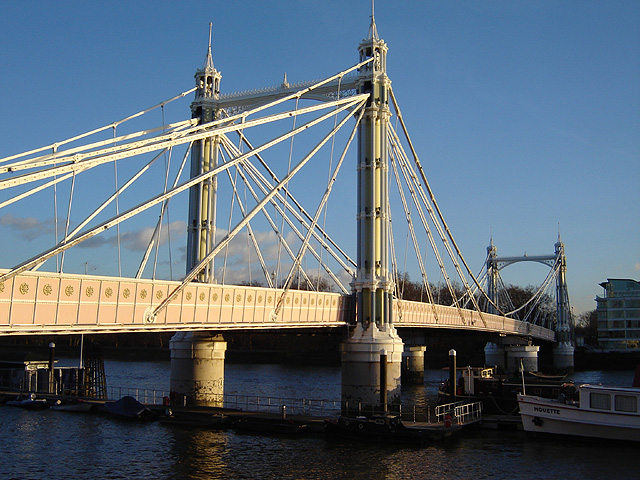Ordish–Lefeuvre system on:
[Wikipedia]
[Google]
[Amazon]
 The Ordish–Lefeuvre system or principle is an early form of cable-stayed bridge design, patented by English engineers Rowland Mason Ordish and
The Ordish–Lefeuvre system or principle is an early form of cable-stayed bridge design, patented by English engineers Rowland Mason Ordish and  Albert Bridge was inspected in 1884 by Sir Joseph Bazalgette, Chief Engineer of the Metropolitan Board of Works, who found that the steel rods were already showing serious signs of corrosion. Over the next three years the steel staying rods were augmented with steel chains, giving it an appearance more closely resembling a conventional suspension bridge, and a new timber deck was laid. Albert Bridge continued to suffer serious structural weakness and in 1972 the
Albert Bridge was inspected in 1884 by Sir Joseph Bazalgette, Chief Engineer of the Metropolitan Board of Works, who found that the steel rods were already showing serious signs of corrosion. Over the next three years the steel staying rods were augmented with steel chains, giving it an appearance more closely resembling a conventional suspension bridge, and a new timber deck was laid. Albert Bridge continued to suffer serious structural weakness and in 1972 the
 The Ordish–Lefeuvre system or principle is an early form of cable-stayed bridge design, patented by English engineers Rowland Mason Ordish and
The Ordish–Lefeuvre system or principle is an early form of cable-stayed bridge design, patented by English engineers Rowland Mason Ordish and William Henry Le Feuvre
William Henry Le Feuvre (1832–1896) was an English engineer, born on the island of Jersey. He was president of the Society of Engineers The Society of Engineers was a British learned society established in 1854. It was the first society to issue ...
in 1858.
The Ordish–Lefeuvre system differs from conventional suspension bridge
A suspension bridge is a type of bridge in which the deck (bridge), deck is hung below suspension wire rope, cables on vertical suspenders. The first modern examples of this type of bridge were built in the early 1800s. Simple suspension bridg ...
s in that, while as with a conventional suspension bridge a parabolic cable supports the centre of the bridge, inclined stays support the remainder of the bridge's load. Each stay consists of a flat wrought iron bar attached to the bridge deck, and a wire rope connects the wrought iron bar to one of four octagonal support columns.
Only two major bridges were built using the Ordish–Lefeuvre principle. Ordish was commissioned to build Albert Bridge in Chelsea, London, using the design in 1864, but the start of work on the bridge was delayed due to negotiations regarding the proposed Chelsea Embankment at the northern end of the proposed bridge. While plans for the Chelsea Embankment were debated, Ordish built the Franz Joseph Bridge
Franz Joseph Bridge ( cz, Most Františka Josefa), later renamed Štefanik Bridge ( cz, Štefánikův most), was a suspension bridge over the Vltava in Prague, opened in 1868.
The bridge was designed by the English engineer Rowland Mason Ordish ...
over the Vltava in Prague to the same design as that intended for Albert Bridge.
In 1870 work finally began on Albert Bridge, with construction expected to take roughly a year. In the event, construction took over three years, and the bridge opened with no formal ceremony on 23 August 1873, almost ten years after it had been authorised.
 Albert Bridge was inspected in 1884 by Sir Joseph Bazalgette, Chief Engineer of the Metropolitan Board of Works, who found that the steel rods were already showing serious signs of corrosion. Over the next three years the steel staying rods were augmented with steel chains, giving it an appearance more closely resembling a conventional suspension bridge, and a new timber deck was laid. Albert Bridge continued to suffer serious structural weakness and in 1972 the
Albert Bridge was inspected in 1884 by Sir Joseph Bazalgette, Chief Engineer of the Metropolitan Board of Works, who found that the steel rods were already showing serious signs of corrosion. Over the next three years the steel staying rods were augmented with steel chains, giving it an appearance more closely resembling a conventional suspension bridge, and a new timber deck was laid. Albert Bridge continued to suffer serious structural weakness and in 1972 the Greater London Council
The Greater London Council (GLC) was the top-tier local government administrative body for Greater London from 1965 to 1986. It replaced the earlier London County Council (LCC) which had covered a much smaller area. The GLC was dissolved in 198 ...
added two concrete piers in the middle of the river, supporting the central span and turning the central section of the bridge into a beam bridge
Beam bridges are the simplest structural forms for bridge spans supported by an abutment or pier at each end. No moments are transferred throughout the support, hence their structural type is known as '' simply supported''.
The simplest beam ...
.
Damaged through overuse during the Second World War, the Franz Joseph Bridge was demolished in the 1950s and replaced with a conventional bridge, leaving Albert Bridge the only surviving example of a significant bridge built using the Ordish–Lefeuvre principle.
Notes and references
;References ;Bibliography * * * * * * {{DEFAULTSORT:Ordish-Lefeuvre system Bridges 1858 introductions